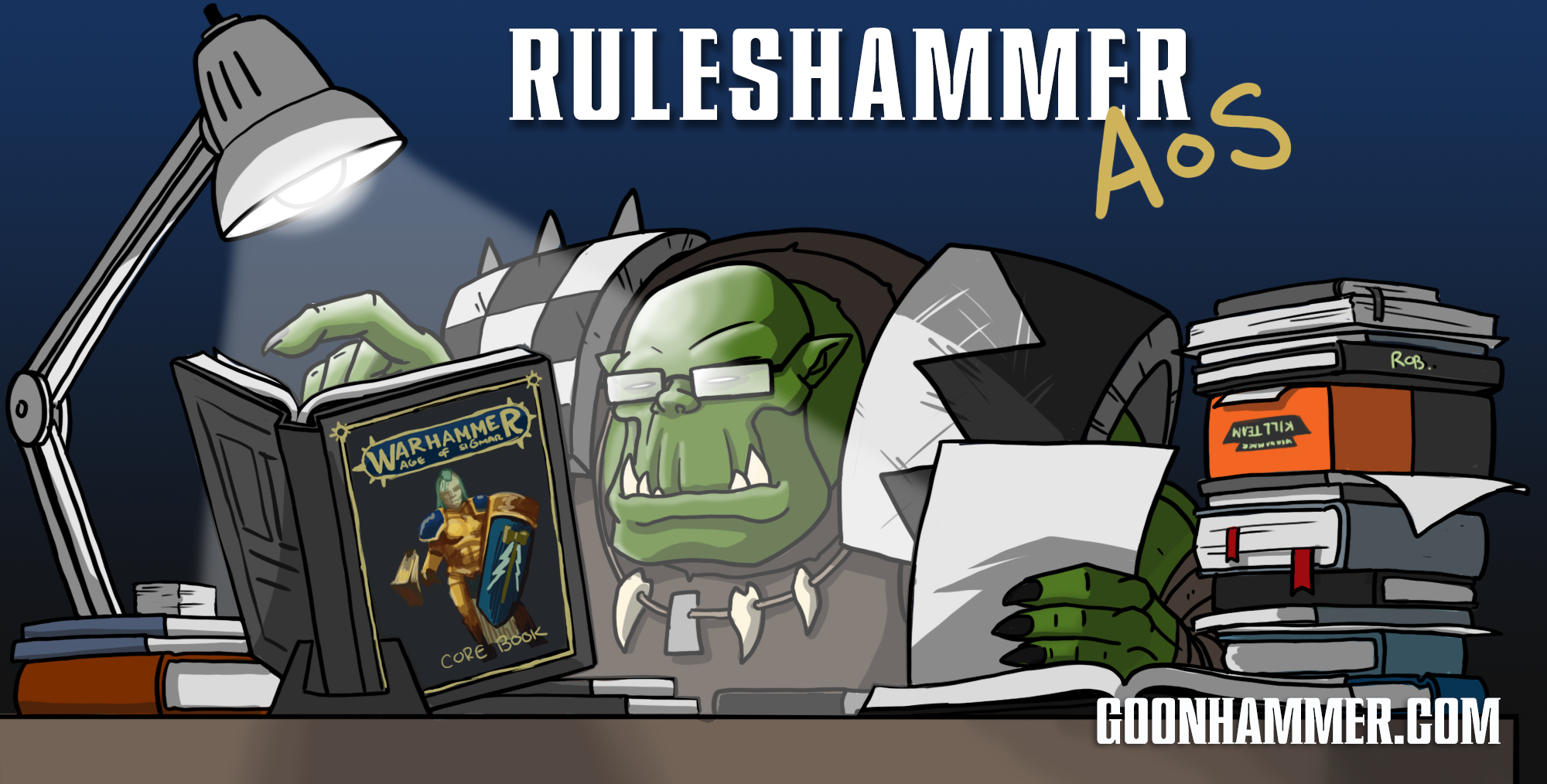“You must be shapeless, formless, like water. When you pour water in a cup, it becomes the cup. When you pour water in a bottle, it becomes the bottle. When you pour water in a teapot, it becomes the teapot. Water can drip and it can crash. Become like water my friend.”
The game is changing, and we’re all going to need to learn new skills. What we’ll be tackling today is one of the more controversial aspects of early 3rd edition: the changes to coherency.
We’ll set out what these changes are, and what they mean for your games. The heartbeat of the article is what we can do to maximize these rules in a practical sense, then we’ll wrap up with value judgments on whether or not these are A Good Thing.
Ready? Let’s go.
The Rule
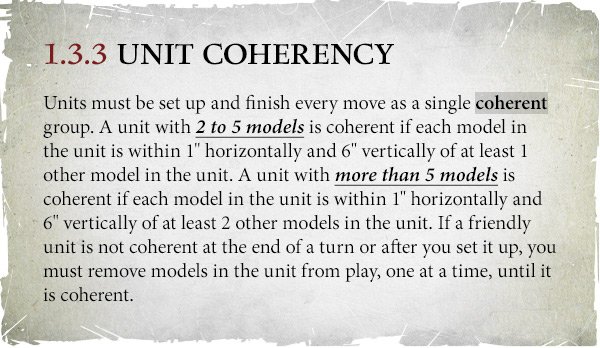
So in units of 6+, we need to be near two models, instead of one. OK, we can do that.
Fundamentally, what this means is that the models in the middle of units are fine – it’s the ones that are on the edges that we have to be careful around. Perhaps the most important thing to think about is what could become the edges, after models are removed: we need to make our units safe from being zapped all the way down to five models after a single one is removed.
Foreword: What You CAN’T Do…
There were some pictures going around of little bubbles of models, spread out all across the board, and the advocates of this theory seemed to enjoy themselves arguing that it was legit.
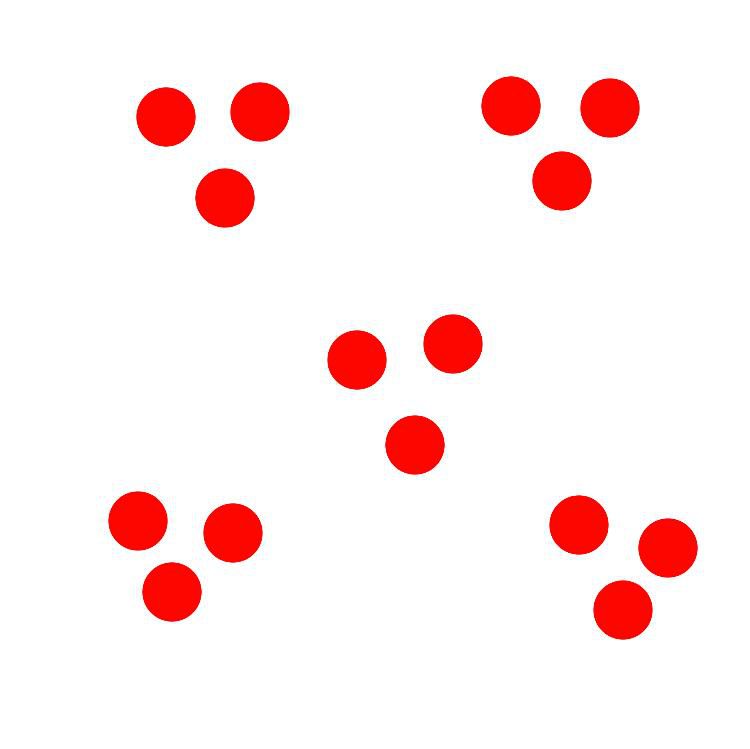
Don’t be silly.
You can argue it works by the rules, and sure it does, but you’re gonna be seen as a real jerk to do so.
…And What You WON’T Do
What the rules seem to want you to do is charge in two ranks, like a good little soldier:
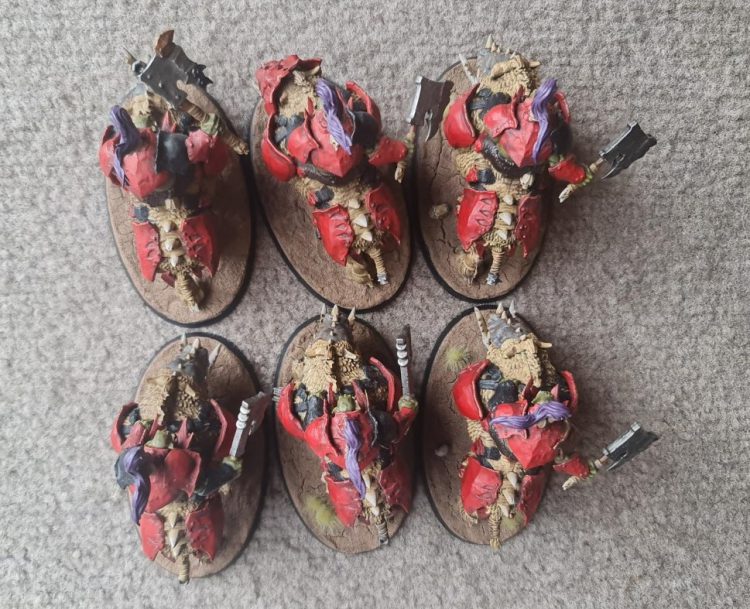
This means wasting half your output. Don’t do that. We’re here today to tell you that there are other, better options.
You’ll no longer be able to put everything blindly in a straight line, but we also don’t want to just stack everything into wildly inefficient ranks, so let’s take a look at some formations we can make use of.
The Formations
The “Who Cares?”
Do you know how big an inch is, in metric terms? It’s 25.4mm, so crucially it’s slightly more than a 25mm base.
Models on 25mms can string out sideways and be within an inch of what’s on each side: the 25mm base inbetween them puts them less than 25.4mm (or 1″) from the next model across, by definition:

This is a really safe shape, and removing models from either end will never cause chain reaction removal across the line.
Similarly, they can fight over the top of the guy in front:

Again the 25mm base in front of them is less than the 25.4mm reach they have, so they can hit over the top.
Having troops on 25s has long been a big advantage in Age of Sigmar, and looks set to become an even bigger factor in the new edition.
The Dumbbell
Who says we can’t string ’em out? You just try and stop us!

We can establish two things here. Firstly, under the harsh glare of a close-up camera shot, that carpet could definitely use a good clean.
Secondly, this formation is a house of cards: as soon as you remove one single model, your edge rushers are isolated and the entire line collapses right back down to 5 models.

When to use it
This doesn’t automatically make it a terrible idea – it can still have situational uses. Hobgrots, for example, are worthless trash whose only purpose is to exist and then die. If you’re using them as a screen to protect your proper units, it may situationally be worthwhile to just string them out and let them cop it.
Anything decent will overkill the entire unit in a single swing regardless, so you might as well just control as much space as possible, then let them fulfill their destiny.
The Smartbell
Taking a step beyond that, we can set up little Firewalls along the way:
 You’ll only ever need to remove models until you get to the next stacker in the line:
You’ll only ever need to remove models until you get to the next stacker in the line:

This is really useful for combat units that also need to control board space: Savage Orruks spring to mind, or anything on small cav bases that wants to fight (such as Spider Riders). In practice that will probably mean getting roughly 8 out of 10 into combat, with minimal risk to coherency-removals.
The Eccentric Dumbbell
Finally in this subsection, it’s worth pointing out the possibility of creating a dumbbell that’s heavily weighted to one side:
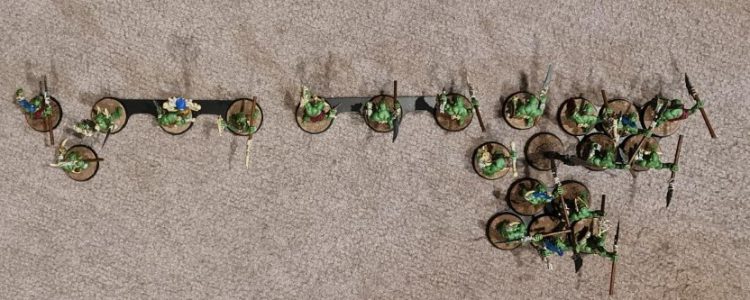
What we’re doing here is stringing out a line (to screen your army in the short term), while stacking models on the Objective (hopefully to hold it for the long term). Depending on what hits you and how hard, what you’re setting up to do is to sacrifice the line, so it snaps back to the big block on the Objective.
The key point here is that you can still conga line out from a blob – you just need to have a triangle on the end, and potentially set up firewall models along the way if you are not willing to lose the whole line.
The Sidescreen

Combat units on small cav bases tend to be underwhelming in Age of Sigmar, with the exception of something like Big Stabbas which have 3″ reach anyway. What they are good for, however, is creating mobile speed bumps, and that hasn’t changed.
5 Boarboys strung out sideways is a great little screening unit, with no coherency issues at all – units like this are a natural fit for an MSU paradigm, zipping off to grab objectives or blocking charges, and if I was cool I’d probably say something about STONKS at this point. Anyway, I’ll be putting ’em in my lists.
The Saw Tooth (32s)
Combat units on 32mm bases with 1″ reach get a raw deal in AOS – Namarti Thralls spring to mind. Minimag Tray* has figured out exactly how wide you need to place your models, to get everyone within 1″:
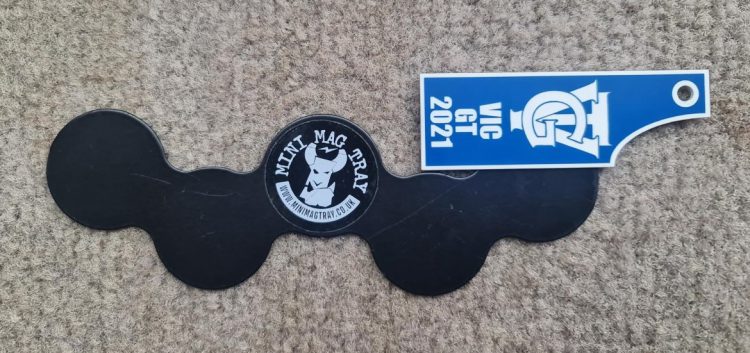
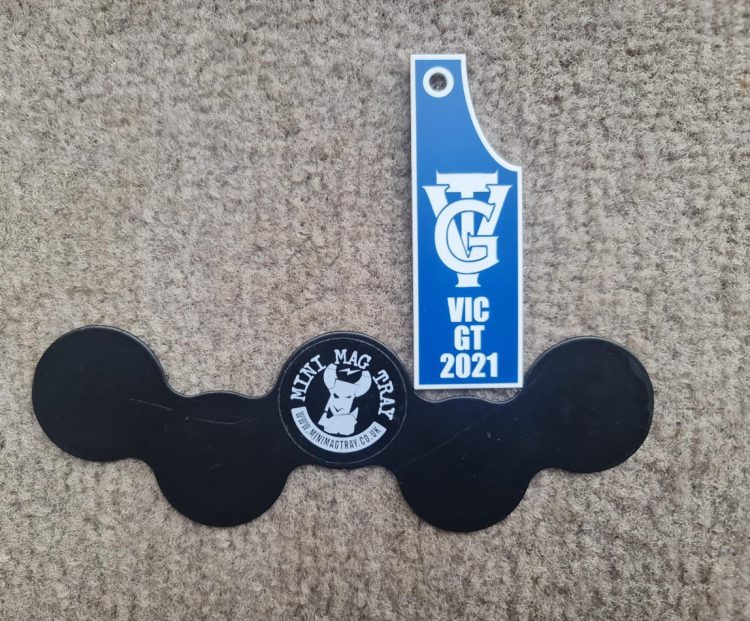
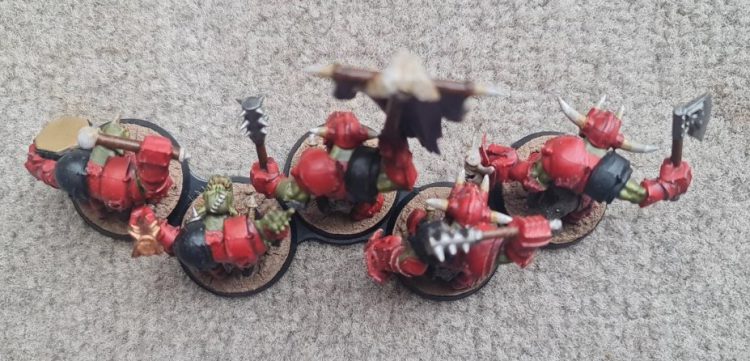
You can of course do this without buying the trays, but they will make life a lot easier.
When to use it
This is the most efficient way to place 32mm troops with 1″ reach, if you are planning on fighting with them.
If they have 2″ range they can fight in two ranks, so who cares; if they are being used to screen and control space, then you’re back to some version of the dumbbell. This formation comes into its own for 32mm combat units like Ardboyz, Namarti and Bloodreavers.
The Eyesore
Wanna fight with all your pigs? This is how you do it:
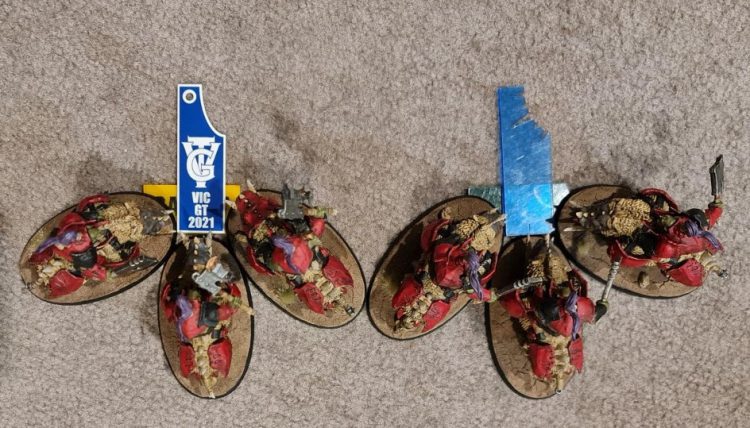
Each model is less than 1″ from the front, and the models on the end are within 1″ of their buddies inside.
And as soon as you lose a single model, you’re back down to a unit size of 5, and don’t need to stress about this stuff any longer.
The Nuclear Option
Worth noting is that you can now run undersized units in Matched Play. For example, you could run a unit of 5 pigs:

And from the Matched Play section:

Screw that. Use the formations in this article, keep your 6th pig as ablative wounds, and as soon as he dies you’re down to 5 models and you’re golden.
Counter-Play to all of the above
If your opponent is running 6 Gore Gruntas, you might not want to set up in a neat, square line for them to hit you face on. Deploy your models in a jagged formation, and your opponent might find that being 0.9″ back is not enough to reach your ranks. Of course they’ll be trying to charge in and tessellate with your lines, and these are the games of cat and mouse we’ll all have to git gud at in future.
Also worth a mention is that abilities that allow removal of specific models are now exponentially more powerful: the harder it is to maintain coherency, the easier it is to blow up half a unit by plucking out a key piece or two.
Sons of Behemat are the masters of this, especially the Warstomper whose ability to remove models is not specifically locked to any particular point in the combat phase, so he can do it after his opponents have piled in to wreak maximum carnage:
Hurled Body: Warstomper Mega-Gargants wade into the thick of battle, and will pick up smaller opponents to hurl at other enemies.
Once per combat phase, you can pick 1 enemy model within 3″ of this model and roll a dice. Add the Hurled Body modifier shown on this model’s damage table to the roll. If the roll is at least double that enemy model’s Wounds characteristic, it is slain and you can roll another dice. On a 4+, you can pick an enemy unit within 12″ of this model and visible to it. That unit suffers a number of mortal wounds equal to the Wounds characteristic of the slain model.
And let’s give a shout out to my boy Lachlan McLean, who pointed out that Teclis can do the same thing at range with this sneaky spell from the Lore of the High Peaks:
|
Entomb The caster points at a foe and closes their hand into a tight fist. The ground opens beneath their victim, engulfing them in a prison made of solid rock. Entomb has a casting value of 7. If successfully cast, pick 1 enemy model within 18″ of the caster and visible to them, and roll a dice. If the roll is greater than that model’s Wounds characteristic, that model is slain. If the roll is a 6 but is not greater than that model’s Wounds characteristic, that model suffers D6 mortal wounds. |
Mortek Crawlers, the Stardrake and even the Troggboss and Ghorgon can do similar things, so watch out.
Does it work?
Do these rules meet their intended goals? Let’s tackle the potential design goals for the new edition, one by one:
Aesthetics, or Muh Immersion
Does this reduce or remove conga lines, making the game look more like “real armies” going at it?
Absolutely not. If that was the goal, this rule is already an abject failure, in every possible way:
- The shapes and formations that we’re going to have to use are jankier and uglier than ever
- You can still string out across the board
- Even if we played their game: Cavalry charging in neat rows behind each other is the most unimmersive way you could possibly place models
Smooth Gameplay
Absolutely not. There are plenty of ways people can and will work around it, all of which are finnicky, fussy and liable to slow the game down. People will go to great lengths to make sure they can fight with 6 Gore Gruntas instead of 5 (or prevent their opponent from so doing), so in practice you’ll have a series of minor breakdowns in gameplay as we fidget around with combat gauges.
Haves and Have Nots
Explicitly mentioned as a reason for binning Warscroll Battalions, the gulf between rules Haves and Have Nots is only exacerbated by the new coherency rules.
Coming on 25mm bases was already a huge advantage, and is now even moreso; elite infantry (like Ogor Gluttons) and light cavalry (like Spider Riders) that were generally not in a great place are now even worse off. This rule only exacerbates the Haves and Have Nots.
Gameplay
Yup – it could have a big impact here. GW have decided to shrink the table size for 3rd Ed, and at the very least this rule will compact your screens, creating gaps and charge lanes. That should prove to be a net benefit for the game, although the same thing will be achieved by shrinking unit sizes and general points increases (leading to fewer models on the table in total).
My overall hot take is that the positive impact on gameplay (from shrinking screens) can be and has been achieved in other ways, and is therefore outweighed by the fluency issues above. I’m not whining about losing a crutch here, because I haven’t: I just don’t see enough upsides to make it worth the hassle and awkwardness.
The game will be slightly less smooth and slightly less free-flowing because of this rule. We’ll learn to live with it, but I’d prefer if we didn’t have to.
What I Would Have Done Differently
OK then Mr Smartypants, have you got any constructive suggestions?
Sweet of you to ask!
First up, literally anything that moves on from the Imperial system of measurements is always and automatically a good thing. So let’s move weapon ranges to 25mm – 50mm – 75mm instead of inches: this will mitigate one of the advantages that 25mm bases bring by a quirk of history, and level the playing field slightly for troops on 32mms.
Secondly, let’s make one-model coherency apply for units of 2 to 6 instead of 2 to 5. There are a lot of units in this game that go 3 -> 6 or 2 -> 4 -> 6, and they have been arbitrarily shafted by this rule: Stormcast cavalry, Gore Gruntas, Ogor Gluttons and so on. We know how to work around it – please just relieve us of the tedium and ugly formations required for so doing.
So there you have it! The rule is a minor pain in the butt, but wargamers are smart people and we’ll adapt. The look, feel and flow of a game in 3rd Ed will be very different from 2nd Ed, and the new coherency rules will play a part in changing the shape of a game by compacting units; so hopefully time will prove that it was worthwhile.
If you enjoyed this article, keep an eye on https://plasticcraic.blog/ where I post regularly on Age of Sigmar – see you there!
*Please note that I have no financial interest in Minimag Trays – I am just a paying customer who really likes them!
Next up on Ruleshammer Tour we will be examining the new artefacts and command traits in the core book. See you then! If you have comments or questions leave a message down below or email us at contact@goonhammer.com.
